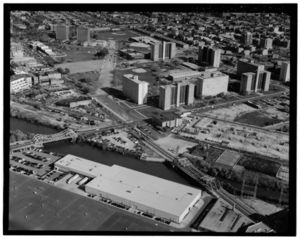From Wikipedia, the free encyclopedia
1999 photograph looking northeast on Chicago's now demolished Cabrini-Green housing project, onef many urban renewal effort.
Urban Renewal (similar to Urban Regeneration in British English) is a controversial US program of land re-development in areas of previous moderate to high density urban land use. This process began an intense phase in the late 1940s and continues to the present day. It has a major impact on the urban landscape. Similar mechanisms play an important role in the history and demographics of cities around the world, including; Beijing, China, Melbourne, Victoria; Saint John, New Brunswick; Glasgow, Scotland; Boston, Massachusetts; San Francisco, California; and Bilbao, Spain. Commonly cited examples include Canary Wharf, in London, and Cardiff in Wales.
Urban renewal is extremely controversial, and typically involves the destruction of businesses, the relocation of people, and the use of eminent domain (known as Compulsory Purchase in the UK) as a legal instrument to reclaim private property for City-initiated development projects. The justifications often used for Urban Renewal include the "renewal" of residential slums, blighted commercial and industrial areas. In the 1960's James Baldwin famously dubbed Urban Renewal "Negro Removal". [1][2][3].
In the second half of the 20th century, renewal often resulted in the creation of urban sprawl and vast areas of cities being demolished and replaced by freeways and expressways, housing projects, and vacant lots, some of which still remain vacant at the beginning of the 21st century.[4]
Urban Renewal's effect on actual revitalization is a subject of intense debate. It is seen by proponents as an economic engine, and by opponents as a regressive mechanism for enriching the wealthy at the expense of taxpayers and the poor. It carries a high cost to existing communities, and in many cases resulted in the destruction of vibrant—if run-down —neighborhoods.
Urban renewal in its original form has been called a failure by many urban planners and civic leaders, and has since been reformulated with a focus on redevelopment of existing communities. However, many cities link the revitalization of the central business district and gentrification of residential neighborhoods to earlier urban renewal programs. Over time, urban renewal evolved into a policy based less on destruction and more on renovation and investment, and today is an integral part of many local governments, often combined with small and big business incentives. But even in this adapted form, Urban Renewal projects are still widely accused of abuse and corruption.








